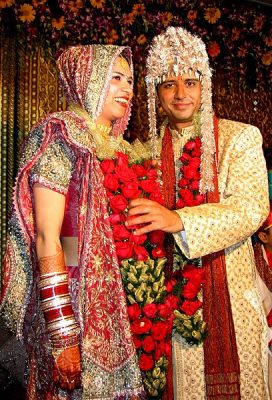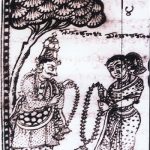In India, marriage is not just a social event or a religious ceremony. It is considered as a sacred institution that binds two individuals together for life. It is a very important event in the life of an Indian woman as it marks the beginning of her new life.
A typical Indian marriage is a grand affair, with a lot of pomp and show. It is a very lavish affair, with a lot of food, music and dance. The bride and groom are decked up in their finery and the guests are also dressed in their best. The bride usually wears a red sari, which is considered to be the most auspicious color in India. The groom usually wears a sherwani, which is a traditional Indian dress. The guests also dress up in their best clothes.
The Indian marriage is a very elaborate affair, with a lot of rituals and ceremonies. The most important ritual is the exchange of marriage vows between the bride and groom. This is followed by the exchange of garlands between the two. After the exchange of garlands, the bride and groom take seven steps around a sacred fire, which is known as the Saptapadi. This is considered to be a very important ritual as it signifies the seven vows that the couple takes during the course of their married life.
The Indian marriage is a very sacred and solemn occasion. It is a day when two individuals come together to start a new life. It is a day when two families come together and bond for life.
In India, marriage is not just a relationship between two individuals, but an occasion where two families come together. It is a very important occasion in the life of every Indian. A marriage in India is usually a very grand affair, with many rituals and ceremonies.
The Indian Constitution provides for the freedom to marry and live with the person of one’s choice. However, there are some restrictions on this freedom. For instance, child marriages and polygamy are not allowed.
There are various types of marriages in India. The most common ones are arranged marriages and love marriages.
In an arranged marriage, the families of the bride and groom come together and agree on the marriage. The bride and groom may not have met each other before the marriage. In a love marriage, the bride and groom marry each other of their own free will.
There are many rituals and ceremonies associated with an Indian marriage. The most important ones are the engagement ceremony, the wedding ceremony and the reception. The engagement ceremony is held a few weeks before the wedding. In this ceremony, the families of the bride and groom exchange gifts and rings. The bride and groom also exchange garlands.
The wedding ceremony is held according to Hindu traditions. The bride and groom exchange flower garlands, take seven rounds around a sacred fire, and exchange wedding vows. After the ceremony, the bride and groom are considered to be husband and wife. The reception is held after the wedding ceremony. In this ceremony, the families of the bride and groom greet each other. They also exchange gifts. The reception is usually a grand affair, with many guests. Marriage is a very important institution in India. It is considered to be a sacred bond between two individuals. A marriage is usually a very grand affair, with many rituals and ceremonies.
Arranged and love marriages are both types of marriages that are commonly practiced in India. While arranged marriages are more traditional and involve the families of the bride and groom choosing a suitable match for their children, love marriages are becoming more popular in India and involve the bride and groom choosing each other.
Both types of marriages have their own advantages and disadvantages, which will be discussed in this article.
Advantages of arranged marriages:
1) Arranged marriages usually take place between two families who are already acquainted with each other, which can help to avoid potential problems that could occur if the families were not familiar with each other.
2) In an arranged marriage, both the families of the bride and groom have a say in who their children marry, which can help to ensure that the couple is compatible with each other.
3) Arranged marriages often result in strong relationships because the couple has the support of their families.
4) Arranged marriages usually take place between people of the same caste and religion, which can help to reduce the chances of conflicts arising from differences in lifestyle or beliefs.
Disadvantages of arranged marriages:
1) Arranged marriages can be seen as a way of controlling the lives of the bride and groom, and may not allow the couple to make their own decisions about their relationship.
2) In some arranged marriages, the bride and groom may not have a say in who they marry, which can lead to them being paired with someone they do not love or are not compatible with.
3) Arranged marriages may put pressure on the couple to stay together even if they are unhappy, as divorce is not always seen as an option.
4) Arranged marriages can be difficult to get out of if the couple decides that they do not want to stay together.
Advantages of love marriages:
1) Love marriages allow the bride and groom to choose each other, which can help to ensure that they are compatible and have similar interests.
2) Love marriages often result in strong relationships because the couple has chosen each other and is more likely to be committed to the relationship.
3) Love marriages can be easier to get out of if the couple is not compatible or if they are unhappy, as divorce is more accepted in love marriages.
4) Love marriages may provide more freedom for the couple to make decisions about their relationship.
Disadvantages of love marriages:
1) Love marriages can be seen as a way of breaking the bonds between families, as the couple has chosen each other without the approval of their families.
2) Love marriages may not have the support of the families of the bride and groom, which can make it difficult for the couple if they face problems.
3) Love marriages may not last as long as arranged marriages, as the couple has not had the support of their families in choosing each other.
4) Love marriages can be more difficult to get out of if the couple has children, as divorce is not always seen as an option.
India is a land of diversity, and this is reflected in its culture, traditions, and customs. One of the most important aspects of Indian culture is marriage. Marriage is considered to be a sacred institution in India, and it is an important social and religious event. Marriage season in India varies from region to region. However, there are some common marriage seasons that are observed in different parts of the country.
The most common marriage season in India is the period between October and March. This is the time when the weather is cool and pleasant, and it is considered to be an auspicious time for marriages. This is also the time when the crops have been harvested and there is plenty of food available.
Another marriage season that is observed in India is the period between April and June. This is the time when the weather is hot and humid, and it is considered to be an inauspicious time for marriages. This is also the time when the crops have not been harvested and there is a shortage of food
The third marriage season in India is the period between July and September. This is the time when the weather is cool and pleasant, and it is considered to be an auspicious time for marriages. This is also the time when the crops have been harvested and there is plenty of food available.
The fourth marriage season in India is the period between October and December. This is the time when the weather is cold and dry, and it is considered to be an inauspicious time for marriages. This is also the time when the crops have not been harvested and there is a shortage of food.
The fifth marriage season in India is the period between January and March. This is the time when the weather is cold and dry, and it is considered to be an inauspicious time for marriages. This is also the time when the crops have not been harvested and there is a shortage of food.
The sixth marriage season in India is the period between April and June. This is the time when the weather is hot and humid, and it is considered to be an inauspicious time for marriages. This is also the time when the crops have not been harvested and there is a shortage of food.
The seventh marriage season in India is the period between July and September. This is the time when the weather is cool and pleasant, and it is considered to be an auspicious time for marriages. This is also the time when the crops have been harvested and there is plenty of food available.
The eighth marriage season in India is the period between October and December. This is the time when the weather is cold and dry, and it is considered to be an inauspicious time for marriages. This is also the time when the crops have not been harvested and there is a shortage of food.
The ninth marriage season in India is the period between January and March. This is the time when the weather is cold and dry, and it is considered to be an inauspicious time for marriages. This is also the time when the crops have not been harvested and there is a shortage of food.
The tenth marriage season in India is the period between April and June. This is the time when the weather is hot and humid, and it is considered to be an inauspicious time for marriages. This is also the time when the crops have not been harvested and there is a shortage of food.
Marriage is one of the most important occasions in India. It is a very joyous and auspicious occasion. The marriage ceremony is a very elaborate affair with many pre-wedding, wedding and post-wedding rituals.
The prewedding rituals include things like the engagement ceremony, the mehendi ceremony, the sangeet ceremony etc. The engagement ceremony is when the families of the bride and groom exchange rings and formally announce the engagement. The mehendi ceremony is when the bride gets her mehendi (henna) done. The sangeet ceremony is a fun night where all the ladies of the family and friends get together and sing and dance.
The wedding day is when the actual marriage ceremony takes place. The ceremony is conducted by a priest and is very sacred. The bride and groom exchange garlands, take the seven sacred rounds around the fire and exchange vows. After the ceremony, the couple is declared husband and wife. The postwedding rituals include things like the reception, the vidaai (when the bride leaves her parents’ home), the annaprashan (when the baby is fed solid food for the first time) etc.
The reception is a grand party thrown by the groom’s family to celebrate the marriage. The vidaai is an emotional moment when the bride leaves her parents’ home to start her new life with her husband. The annaprashan is a joyous occasion when the baby is fed solid food for the first time. Marriage is a very important occasion in India and is celebrated with much joy and enthusiasm.
Hindu marriages in India are a sacred and holy affair. The bride and groom exchange garlands and take seven steps around a sacred fire, vowing to remain together forever. The bride’s father then gives her away to the groom, who places a ring on her finger. The marriage ceremony is conducted by a priest and is followed by a feast. After the wedding, the couple is considered to be married for life.
They may have children and live together as a family. Hindu marriages are not just about two people getting married; they are also about two families coming together. The families of the bride and groom exchange gifts and bless the couple. Hindu marriages are a very important part of Hindu culture. They are a way for two people to come together and start a new life. Hindu marriages are also a way for families to strengthen their bonds and relationships.












